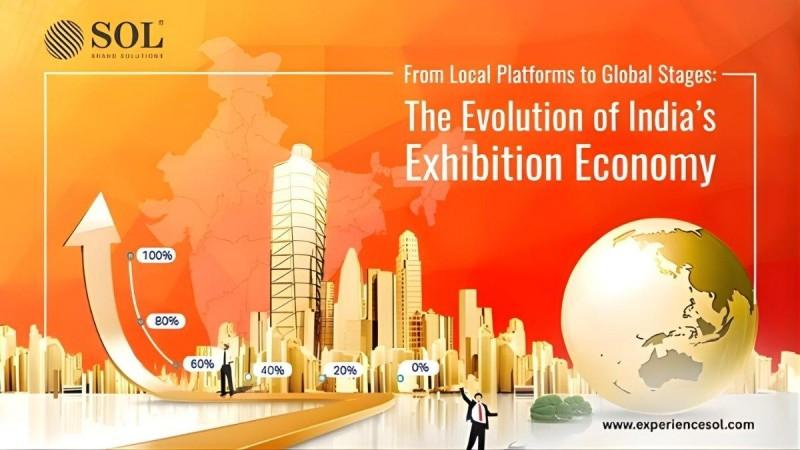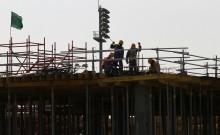
The Indian exhibition economy has rapidly expanded from village fairs and trade haats to full-blown convention centres, resulting in job creation, increased tourist arrivals, and brand selling across borders. Face-to-face trading that used to be confined locally now manifests as product launches, partnerships, and investments globally.
At the centre of this shift are the people who make ideas visible. A Stall Fabricator or Stand Builder goes way beyond mere carpentry. It takes a professional creative agency to map out, conceive, and build the stunning stands, which not only catch the attention of the visitors but also communicate the brand message clearly. Their job is to combine all the aspects of design, materials, and space planning so that every square foot works hard.
The Roots of India's Exhibition Economy: Starting Small and Local
The whole of India's exhibition saga began at upmarket schools, gardens, and outdoor spaces of the districts. These initial gatherings provided a platform for the producers, helped in the creation of a trust between the customers and the sellers, and laid down practices which still determine how we interact with traders at fairs today. This local exhibition history in India explains why today's floors feel lively, social, and sales-focused.
It started right after independence in 1947. Local events helped new industries share ideas and sell goods within the country. Over time, they built a base for bigger things.
Key Historical Milestones in Local Exhibitions
Small formats matured through a series of visible moments. Each one expanded footfall, organising power, and access for small firms.
1. All India Industrial Exhibition, Hyderabad (Numaish), 1938
Such a regional event was a turning point that allowed the artisans, handloom cooperatives, and small traders to get seasonal business, direct customer interaction and even recognition of their products across the nation.
2. IMTEX (Indian Machine Tool Exhibition), Mumbai, 1969
The exhibition was India's first big-scale engineering and manufacturing show that was to be the model of future industrial B2B fairs.
3. Asia 72, Pragati Maidan, New Delhi, 1972
The global exposition was not only a fantastic occasion to celebrate the 25th anniversary of independence but also to open new kiosks that finally made Pragati Maidan the top exhibition place in India.
4. India International Trade Fair (IITF), Pragati Maidan, Delhi, 1980
The exhibition was promoted as the government's foremost annual exhibition and merged both B2B and B2C participation, thereby facilitating trade over several sectors.
5. Chennai Trade Centre Inauguration, 2001
The inauguration of Chennai Trade Centre was one of the first major government-assisted convention facilities located outside Delhi, and it showed the country's commitment to the south in the matter of exhibitions.
6. Calcutta's Indian International Exhibition, 1883–84
Though under British control, this event opened a door of opportunity for Indian manufacturers, textile makers, and artisans for the world to know their existence. It attracted the attention of trade and civil administration, which facilitated the small producers' testing of demand, securing orders, and learning the basic display techniques that eventually led to better product presentation.
7. Bangalore International Exhibition Centre (BIEC), 2007
Biec accommodated IMTEX 2007 and assisted in making Bengaluru the hub for large industrial and engineering exhibitions in India.
8. Plast India, Pragati Maidan, New Delhi, 2016
A large international expo of the plastics and polymer industry, which showcased India's potential as a host for the global-scale, sustainable and innovation-driven trade fairs.
9. Bharat Mandapam at Pragati Maidan (New Delhi), 2023–24
A futuristic exhibition and convention complex opened during India's G20 presidency, signifying India's transformation to the global exhibition stage.
10. Screen Print India Expo, Jio World Convention Centre, Mumbai, 2025
Stands for the new generation of trade shows that are not only creative but also specialised and take place in top-notch venues, showcasing India's fully developed exhibition economy.
The Indian Exhibition Landscape: Challenges and Innovations
Today's scene faces tests but adapts quickly. From pandemics to tech shifts, innovations keep trade shows in India alive. The future of India's trade shows looks bright with smart changes.
The Road Ahead: Future Prospects of India's Exhibition Economy
Growth awaits as India eyes Asia's centre stage. Trends like AI match buyers fast. Ties to Make in India will fuel this.
Trends and Opportunities
- Digital twins mimic events online.
- Metaverse fairs let avatars deal.
- Renewables sectors see big potential in green expos.
India's Global Leap: From Regional Player to International Powerhouse
India's exhibition presence has expanded from regional showcases to global stages where real trade, tech, and policy deals take shape. For any brand planning to scale exports, this surge means better buyer access, higher-quality footfall, and stronger platforms where a stall fabricator and stand builder can turn attention into pipeline.
In conclusion, India has evolved when it comes to the exhibition scene, but without hampering its roots. The tambu and tent system beautifully co-exists with the modern rigged trusses with LED at the state-of-the-art Jio Convention Centre. If you need an agency that has global understanding yet local relevance, then SOL Brand Solutions is your one-stop agency in India. They are not just a stall fabricator; they are a complete exhibition partner who takes care of everything from design to execution with their vast experience.
















